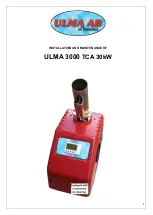
CARE AND OPERATION
PAGE 26
DAMPER OPERATION (All models)
The damper is a plate that helps control the amount of
airflow supplied for combustion. With the damper pushed
all the way in the airflow is at its minimum. As the damper
is pulled out, more air is allowed to flow.
It will be necessary to monitor the appearance of the
flame during the first 4-8 bags of pellets. If your flame is
smoky red / orange with evidence of soot at the top of the
flame, you need more combustion air; pull the damper
out one notch and re-evaluate the appearance of the
flame. It may be necessary to continue this process, mov-
ing the damper one notch at a time until proper combus-
tion is attained (the flame should become yellow and be-
gin to “dance”). If the flame is “short” at the higher burn
rates, or if the pellets are burning up in the grate before
new pellets are fed into the fire, push the damper in one
notch and monitor the flame. Continue the process of
moving the damper one notch at a time and evaluating
the flame until proper flame appearance is achieved.
Once the damper has been properly set, it should not
need adjusting unless you are changing the grade of pel-
let fuel, in which case the damper may need to adjusted.
DAMPER ADJUSTMENT GUIDELINE
Lack of Combustion Air:
By opening the damper, this
will increase combustion air delivery. Symptoms of insuf-
ficient combustion air include; unburned fuel, lazy smoky
or red / orange flame, excessive ash or soot, excessive
buildup on glass.
Contributing factors:
•
High Altitude – Lack of oxygen
•
Restrictive Venting (elbows, horizontal runs,
cold external chimneys, etc.).
•
Dirty / Poor Quality Fuel.
Note: Excessive amounts of fly ash built-up in the grate,
clinkers in the grate or leakage of air (if the grate is not
properly seated) will starve the fire for air. See
Routine
Maintenance
, on page 28 to 33 for information on clean-
ing the stove.
Excessive Combustion Air:
By closing the damper, this
will reduce combustion air delivery. Symptoms of excessive
air include; fuel burns too quickly (results in smoking or
smoldering pellets), white to yellow flame, etc. If the
damper is open too much, the burning pellets will lift off
the grate and fly up into the air much like popping corn
does.
Contributing
factor:
•
Venting system providing excessive draft.
Correct
Combustion Air / Proper Burn Characteris-
tics:
When the damper is correctly set, the burning pel-
lets should move (wiggle) around slightly and the flame
should be bright yellow.
AUTOMATIC SAFETY FEATURES
Power Outage:
During a power outage, the stove will shut down safely.
The stove will automatically restart when power is re-
sumed. The solid state control board has an internal
memory that will retain heat output and blower speed
settings through voltage interruptions.
A small amount of smoke may leak from the top of
the window glass, the hopper and from the combus-
tion air intake, if the stove is vented horizontally with
no vertical pipe.
This will not persist for more than 3 to 5
minutes and will not be safety hazard. It may set off your
smoke alarm.
Note: If the area in which you live is prone to frequent
power outages, it is recommended that a minimum of 8
feet (2 ½ meters) of vertical vent pipe be included in a
freestanding installation to induce a natural draft in the
event of a power failure.
Overheating:
A high temperature disc (thermal switch) will automati-
cally shut down the stove if it overheats. Allow up to 45
minutes cooling time before re-lighting. Keep enough
convection air (from the room air blower) going through
stove to keep it cooling properly, this will ensure long life
of the stove. If the overheating continues, contact your
authorized Lennox Hearth Products dealer for more in-
formation.
Summary of Contents for Advantage Optima 2 FS
Page 38: ...WIRING DIAGRAM PAGE 38 ...
Page 44: ...REPLACEMENT PARTS DIAGRAMS PAGE 44 5 6 8 10 13 14 9 12 7 11 ...
Page 45: ...REPLACEMENT PARTS DIAGRAMS PAGE 45 15 16 17 19 20 22 24 25 26 27 18 23 ...
Page 46: ...REPLACEMENT PARTS DIAGRAMS PAGE 46 30 37 38 40 41 29 28 33 34 39 31 32 35 ...
Page 47: ...REPLACEMENT PARTS DIAGRAMS PAGE 47 43 44 45 46 47 42 ...
Page 49: ...INSTALLATION TIPS PAGE 49 ...
















































